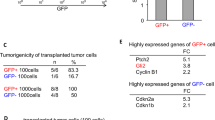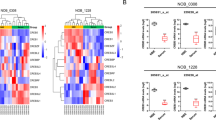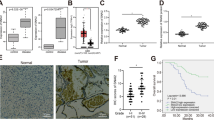Abstract
Polycomb group (PcG) proteins play an important role in development and stem cell maintenance, and their dysregulation have been closely linked to oncogenesis and cancer stem cell phenotypes. Here, we found that nervous system polycomb 1 (NSPc1) was highly expressed in stem cell-like glioma cells (SLCs). Knockdown of NSPc1 in SLCs resulted in impaired neurosphere formation and self-renewal abilities, down-regulated expression of stemness markers such as NESTIN, CD133 and SOX2, and decreased capacity to propagate subcutaneous xenografts. In contrast, glioma cells overexpressing NSPc1 exhibited a stem cell-like phenotype, up-regulated expression of stemness markers NESTIN, CD133 and SOX2, and an enhanced capacity to propagate subcutaneous xenografts. Furthermore, we identified that NSPc1 epigenetically repressed the expression of retinol dehydrogenase 16 (RDH16) by directly binding to a region upstream (−1073 to −823) of the RDH16 promoter. Next, we confirmed that RDH16 is a stemness suppressor that partially rescues SLCs from the NSPc1-induced increase in neurosphere formation. Finally, we showed that ATRA partly reversed the NSPc1-induced stemness enhancement in SLCs, through mechanisms correlated with an ATRA-dependent decrease in the expression of NSPc1. Thus, our results demonstrate that NSPc1 promotes cancer stem cell self-renewal by repressing the synthesis of ATRA via targeting RDH16 and may provide novel targets for glioma treatment in the future.
This is a preview of subscription content, access via your institution
Access options
Subscribe to this journal
Receive 50 print issues and online access
$259.00 per year
only $5.18 per issue
Buy this article
- Purchase on Springer Link
- Instant access to full article PDF
Prices may be subject to local taxes which are calculated during checkout







Similar content being viewed by others
References
Wang H, Xu T, Jiang Y, Xu H, Yan Y, Fu D et al. The Challenges and the Promise of Molecular Targeted Therapy in Malignant Gliomas. Neoplasia 2015; 17: 239–255.
Jiang T, Mao Y, Ma W, Mao Q, You Y, Yang X et al. CGCG clinical practice guidelines for the management of adult diffuse gliomas. Cancer Lett 2016; 375: 263–273.
Ostrom QT, Gittleman H, Stetson L, Virk SM, Barnholtz-Sloan JS . Epidemiology of gliomas. Cancer Treat Res 2015; 163: 1–14.
Jordan CT . Cancer stem cell biology: from leukemia to solid tumors. Curr Opin Cell Biol 2004; 16: 708–712.
Liang Y, Feng Q, Hong J, Feng F, Sang Y, Hu W et al. Tumor growth and metastasis can be inhibited by maintaining genomic stability in cancer cells. Front Med 2015; 9: 57–62.
Aguilar-Gallardo C, Simón C . Cells, Stem Cells, and Cancer Stem Cells. Semin Reprod Med 2013; 31: 5–13.
Visvader JE, Lindeman GJ . Cancer stem cells: current status and evolving complexities. Cell Stem Cell 2012; 10: 717–728.
Yin CL, Lv SQ, Chen XY, Guo H . The role of glioma stem cells in glioma tumorigenesis. Front Biosci 2014; 19: 818–824.
Hemmati HD, Nakano I, Lazareff JA, Masterman-Smith M, Geschwind DH, Bronner-Fraser M et al. Cancerous stem cells can arise from pediatric brain tumors. Proc Natl Acad Sci USA 2003; 100: 15178–15183.
Singh SK, Clarke ID, Terasaki M, Bonn VE, Hawkins C, Squire J et al. Identification of a cancer stem cell in human brain tumors. Cancer Res 2003; 63: 5821–5828.
Singh SK, Hawkins C, Clarke ID, Squire JA, Bayani J, Hide T et al. Identification of human brain tumour initiating cells. Nature 2004; 432: 396–401.
Kondo T, Setoguchi T, Taga T . Persistence of a small subpopulation of cancer stem-like cells in the C6 glioma cell line. Proc Natl Acad Sci USA 2004; 101: 781–786.
Chockalingam S, Ghosh SS . Amelioration of cancer stem cells in macrophage colony stimulating factor-expressing U87MG-human glioblastoma upon 5-fluorouracil therapy. PLoS One 2013; 8: e83877.
Yu SC, Ping YF, Yi L, Zhou ZH, Chen JH, Yao XH et al. Isolation and characterization of cancer stem cells from a human glioblastoma cell line U87. Cancer Lett 2008; 265: 124–134.
Stiles CD, Rowitch DH . Glioma stem cells: a midterm exam. Neuron 2008; 58: 832–846.
Sparmann A, van Lohuizen M . Polycomb silencers control cell fate, development and cancer. Nat Rev Cancer 2006; 6: 846–856.
Levine SS, Weiss A, Erdjument-Bromage H, Shao Z, Tempst P, Kingston RE . The core of the polycomb repressive complex is compositionally and functionally conserved in flies and humans. Mol Cell Biol 2002; 22: 6070–6078.
Wang L, Brown JL, Cao R, Zhang Y, Kassis JA, Jones RS . Hierarchical recruitment of polycomb group silencing complexes. Mol Cell 2004; 14: 637–646.
Schwartz YB, Pirrotta V . Polycomb complexes and epigenetic states. Curr Opin Cell Biol 2008; 20: 266–273.
Richly H, Aloia L, Di Croce L . Roles of the Polycomb group proteins in stem cells and cancer. Cell Death Dis 2011; 2: e204.
Iwama A, Oguro H, Negishi M, Kato Y, Morita Y, Tsukui H et al. Enhanced self-renewal of hematopoietic stem cells mediated by the polycomb gene product Bmi-1. Immunity 2004; 21: 843–851.
Park IK, Qian D, Kiel M, Becker MW, Pihalja M, Weissman IL et al. Bmi-1 is required for maintenance of adult self-renewing haematopoietic stem cells. Nature 2003; 423: 302–305.
Molofsky AV, He S, Bydon M, Morrison SJ, Pardal R . Bmi-1 promotes neural stem cell self-renewal and neural development but not mouse growth and survival by repressing the p16Ink4a and p19Arf senescence pathways. Genes Dev 2005; 19: 1432–1437.
Yadirgi G, Leinster V, Acquati S, Bhagat H, Shakhova O, Marino S . Conditional activation of Bmi1 expression regulates self-renewal, apoptosis, and differentiation of neural stem/progenitor cells in vitro and in vivo. Stem Cells 2011; 29: 700–712.
Chen H, Zhou L, Dou T, Wan G, Tang H, Tian J . BMI1'S maintenance of the proliferative capacity of laryngeal cancer stem cells. Head Neck 2011; 33: 1115–1125.
Smith LL, Yeung J, Zeisig BB, Popov N, Huijbers I, Barnes J et al. Functional crosstalk between Bmi1 and MLL/Hoxa9 axis in establishment of normal hematopoietic and leukemic stem cells. Cell Stem Cell 2011; 8: 649–662.
Wang X, Venugopal C, Manoranjan B, McFarlane N, O'Farrell E, Nolte S et al. Sonic hedgehog regulates Bmi1 in human medulloblastoma brain tumor-initiating cells. Oncogene 2012; 31: 187–199.
Abdouh M, Facchino S, Chatoo W, Balasingam V, Ferreira J, Bernier G . BMI1 sustains human glioblastoma multiforme stem cell renewal. J Neurosci 2009; 29: 8884–8896.
Siddikuzzaman, Guruvayoorappan C, Berlin GV . All trans retinoic acid and cancer. Immunopharmacol Immunotoxicol 2011; 33: 241–249.
Sakoe Y, Sakoe K, Kirito K, Ozawa K, Komatsu N . FOXO3A as a key molecule for all-trans retinoic acid-induced granulocytic differentiation and apoptosis in acute promyelocytic leukemia. Blood 2010; 115: 3787–3795.
Gudas LJ, Wagner JA . Retinoids regulate stem cell differentiation. J Cell Physiol 2011; 226: 322–330.
Jurcic JG, Soignet SL, Maslak AP . Diagnosis and treatment of acute promyelocytic leukemia. Curr Oncol Rep 2007; 9: 337–344.
Ying M, Wang S, Sang Y, Sun P, Lal B, Goodwin CR et al. Regulation of glioblastoma stem cells by retinoic acid: role for Notch pathway inhibition. Oncogene 2011; 30: 3454–3467.
Choschzick I, Hirseland E, Cramer H, Schultz S, Leppert J, Tronnier V et al. Responsiveness of stem-like human glioma cells to all-trans retinoic acid and requirement of retinoic acid receptor isotypes alpha, beta and gamma. Neuroscience 2014; 279: 44–64.
Nunes M, Blanc I, Maes J, Fellous M, Robert B, McElreavey K . NSPc1, a novel mammalian Polycomb gene, is expressed in neural crest-derived structures of the peripheral nervous system. Mech Dev 2001; 102: 219–222.
Gong Y, Wang X, Liu J, Shi L, Yin B, Peng X et al. NSPc1, a mainly nuclear localized protein of novel PcG family members, has a transcription repression activity related to its PKC phosphorylation site at S183. FEBS Lett 2005; 579: 115–121.
Ishida A, Asano H, Hasegawa M, Koseki H, Ono T, Yoshida MC et al. Cloning and chromosome mapping of the human Mel-18 gene which encodes a DNA-binding protein with a new 'RING-finger' motif. Gene 1993; 129: 249–255.
Gong Y, Yue J, Wu X, Wang X, Wen J, Lu L et al. NSPc1 is a cell growth regulator that acts as a transcriptional repressor of p21Waf1/Cip1 via the RARE element. Nucleic Acids Res 2006; 34: 6158–6169.
Wu X, Gong Y, Yue J, Qiang B, Yuan J, Peng X . Cooperation between EZH2, NSPc1-mediated histone H2A ubiquitination and Dnmt1 in HOX gene silencing. Nucleic Acids Res 2008; 36: 3590–3599.
Zhang P, Zhang Y, Mao L, Zhang Z, Chen W . Side population in oral squamous cell carcinoma possesses tumor stem cell phenotypes. Cancer Lett 2009; 277: 227–234.
Li H, Fan R, Sun M, Jiang T, Gong Y . Nspc1 regulates the key pluripotent Oct4-Nanog-Sox2 axis in P19 embryonal carcinoma cells via directly activating Oct4. Biochem Biophys Res Commun 2013; 440: 527–532.
Oliviero G, Munawar N, Watson A, Streubel G, Manning G, Bardwell V et al. The variant Polycomb Repressor Complex 1 component PCGF1 interacts with a pluripotency sub-network that includes DPPA4, a regulator of embryogenesis. Sci Rep 2015; 5: 18388.
Ross K, Sedello AK, Todd GP, Paszkowski-Rogacz M, Bird AW, Ding L et al. Polycomb group ring finger 1 cooperates with Runx1 in regulating differentiation and self-renewal of hematopoietic cells. BLOOD 2012; 119: 4152–4161.
Pavez LE, Chamcheu JC, Vahlquist A, Torma H . Both all-trans retinoic acid and cytochrome P450 (CYP26) inhibitors affect the expression of vitamin A metabolizing enzymes and retinoid biomarkers in organotypic epidermis. Arch Dermatol Res 2009; 301: 475–485.
Napoli JL . Interactions of retinoid binding proteins and enzymes in retinoid metabolism. Biochim Biophys Acta 1999; 1440: 139–162.
Ahmed AU, Auffinger B, Lesniak MS . Understanding glioma stem cells: rationale, clinical relevance and therapeutic strategies. Expert Rev Neurother 2013; 13: 545–555.
Wan F, Zhang S, Xie R, Gao B, Campos B, Herold-Mende C et al. The utility and limitations of neurosphere assay, CD133 immunophenotyping and side population assay in glioma stem cell research. Brain Pathol 2010; 20: 877–889.
Wang J, Sakariassen PO, Tsinkalovsky O, Immervoll H, Boe SO, Svendsen A et al. CD133 negative glioma cells form tumors in nude rats and give rise to CD133 positive cells. Int J Cancer 2008; 122: 761–768.
Moon JH, Yoon BS, Kim B, Park G, Jung HY, Maeng I et al. Induction of neural stem cell-like cells (NSCLCs) from mouse astrocytes by Bmi1. Biochem Biophys Res Commun 2008; 371: 267–272.
Sher F, Boddeke E, Copray S . Ezh2 expression in astrocytes induces their dedifferentiation toward neural stem cells. Cell Reprogram 2011; 13: 1–6.
Wu X, Johansen JV, Helin K . Fbxl10/Kdm2b recruits polycomb repressive complex 1 to CpG islands and regulates H2A ubiquitylation. Mol Cell 2013; 49: 1134–1146.
Duester G . Retinoic acid synthesis and signaling during early organogenesis. Cell 2008; 134: 921–931.
Udali S, Guarini P, Ruzzenente A, Ferrarini A, Guglielmi A, Lotto V et al. DNA methylation and gene expression profiles show novel regulatory pathways in hepatocellular carcinoma. Clin Epigenet 2015; 7: 43.
Kimura M, Takenobu H, Akita N, Nakazawa A, Ochiai H, Shimozato O et al. Bmi1 regulates cell fate via tumor suppressor WWOX repression in small-cell lung cancer cells. Cancer Sci 2011; 102: 983–990.
Acknowledgements
This work was supported by grants from The National Key Research and Development Plan (2016YFC0902502, 2016YFA0100702), 973 project No. 2013CB531304, National Sciences Foundation of China (31671316, 31301152, 31370789, 31670789), CAMS Innovation Fund for Medical Sciences (2016-I2M-1-001, CIFMS, 2016-I2M-2-001, 2016-I2M-1-004). We thank Dr Zeper Abliz and Ruiping Zhang from the State Key Laboratory of Bioactive Substance and Function of Natural Medicines, Institute of Materia Medica, Chinese Academy of Medical Sciences and Peking Union Medical College, for assistance with retinoid quantification.
Author contributions
PH and QX performed most of the experimental work, with assistance from FW, DL, YQ, YH, ZW, SL, NT, QW and LS. TJ provided fresh glioma samples and advice. PH and QX analysed the results, produced figures and wrote preliminary draft of the paper. BY, JY and BQ supervised and analysed results and edited the paper. WH and XP designed, supervised, and analysed experiments and wrote the final draft of the manuscript. All authors approved final version of the manuscript.
Author information
Authors and Affiliations
Corresponding authors
Ethics declarations
Competing interests
The authors declare no conflict of interest.
Additional information
Supplementary Information accompanies this paper on the Oncogene website
Supplementary information
Rights and permissions
About this article
Cite this article
Hu, PS., Xia, QS., Wu, F. et al. NSPc1 promotes cancer stem cell self-renewal by repressing the synthesis of all-trans retinoic acid via targeting RDH16 in malignant glioma. Oncogene 36, 4706–4718 (2017). https://doi.org/10.1038/onc.2017.34
Received:
Revised:
Accepted:
Published:
Issue Date:
DOI: https://doi.org/10.1038/onc.2017.34
This article is cited by
-
CDKN2A promoter methylation enhances self-renewal of glioblastoma stem cells and confers resistance to carmustine
Molecular Biology Reports (2024)
-
MORC4 plays a tumor-promoting role in colorectal cancer via regulating PCGF1/CDKN1A axis in vitro and in vivo
Cancer Gene Therapy (2023)
-
Mechanisms of Polycomb group protein function in cancer
Cell Research (2022)
-
Rewiring of purine metabolism in response to acidosis stress in glioma stem cells
Cell Death & Disease (2021)
-
PCGF1 promotes epigenetic activation of stemness markers and colorectal cancer stem cell enrichment
Cell Death & Disease (2021)



